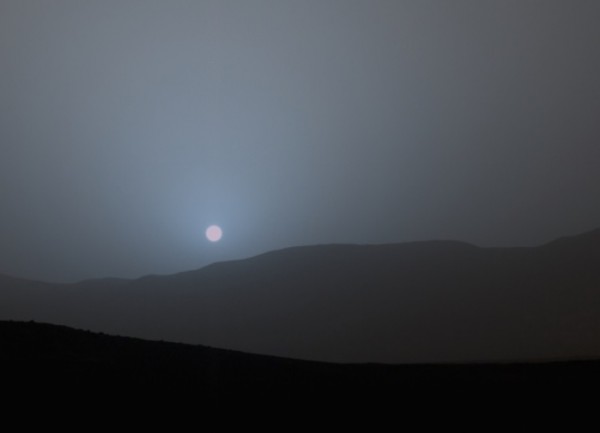How a Sunset on Mars Looks Like Courtesy of NASA's Curiosity Rover
| Ana Verayo | | May 11, 2015 04:04 AM EDT |
(Photo : NASA/JPL-Caltech/MSSS) NASA's Curiosity Mars rover recorded this sequence of views of the sun setting at the close of the mission's 956th Martian day, or sol (April 15, 2015), from the rover's location in Gale Crater.
NASA's Curiosity rover has captured a surreal yet stunning view of a Martian sunset from a vantage point situated in Gale Crater.
However, sunsets on Mars are not always red orange like here on Earth, as the image reveal the sun dipping low on an alien horizon with the most remarkable blue colored sun and sunset skies.
Like Us on Facebook
In order to document this event, Curiosity utitlized its Mast Camera (Mastcam) to record the sunset while observing the Martian night sky last April 15, 2015.
This imaging event was accomplished between dust storms when dust still loomed over the atmosphere in higher elevations.
These observations can provide data for scientists to assess and analyze the vertical distribution of dust occurring on the Red Planet. According to Mark Lemmon from the Texas A&M University in College Station, these colors originate from very fine dust where the dust possesses a specific right size for blue light to penetrate the atmosphere more efficiently.
This blue light scatters off dust as it stays in close proximity with the sun's direction rather than with the other colors from the light.
Lemmon adds that the rest of the sky is tinged with yellow to orange hues since red and yellow light are scattered all over as opposed to being absorbed or staying close to the direction of the sun.
Sunsets on Earth are vivid with yellow, orange and red tones while Martian sunsets are bluish grey as the blue color near the sunlight makes the sky look more prominent as normal Martian daylight enhances the rusty color of the dust.
To date, NASA's Mars Curiosity rover has been exploring the Gale Crater by studying and analyzing its terrain and chemical composition of the planet. This image is taken on the mission's 956th day on Mars.
TagsNASA, Curiosity Rover, Mars, sunset on Mars, photo sunset on Mars
©2015 Chinatopix All rights reserved. Do not reproduce without permission
EDITOR'S PICKS
-

Did the Trump administration just announce plans for a trade war with ‘hostile’ China and Russia?
-

US Senate passes Taiwan travel bill slammed by China
-

As Yan Sihong’s family grieves, here are other Chinese students who went missing abroad. Some have never been found
-

Beijing blasts Western critics who ‘smear China’ with the term sharp power
-

China Envoy Seeks to Defuse Tensions With U.S. as a Trade War Brews
-

Singapore's Deputy PM Provides Bitcoin Vote of Confidence Amid China's Blanket Bans
-

China warns investors over risks in overseas virtual currency trading
-

Chinese government most trustworthy: survey
-

Kashima Antlers On Course For Back-To-Back Titles
MOST POPULAR
LATEST NEWS
Zhou Yongkang: China's Former Security Chief Sentenced to Life in Prison

China's former Chief of the Ministry of Public Security, Zhou Yongkang, has been given a life sentence after he was found guilty of abusing his office, bribery and deliberately ... Full Article
TRENDING STORY

China Pork Prices Expected to Stabilize As The Supplies Recover

Elephone P9000 Smartphone is now on Sale on Amazon India

There's a Big Chance Cliffhangers Won't Still Be Resolved When Grey's Anatomy Season 13 Returns

Supreme Court Ruled on Samsung vs Apple Dispute for Patent Infringement

Microsoft Surface Pro 5 Rumors and Release Date: What is the Latest?










